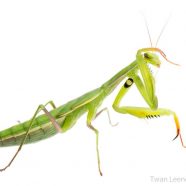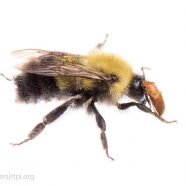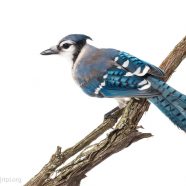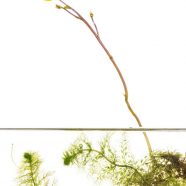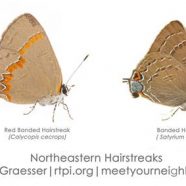European Mantis (Mantis religiosa)
Today our Project Wild America crew let me play with one of their recent encounters, a European Mantis (Mantis religiosa). Jamestown’s urban habitats are just full of cool surprises!
Read MoreBumblebee & Beetle
One of the many, many bumblebees in my yard looked just off. When I caught it for a closer look, it had a hitchhiking beetle attached to one of its antenna! These flower beetles (Antherophaga sp.) feed on flowers as adults, but their larvae feed on detritus inside bumblebee nests. Apparently, the easiest way to get from one place to the other is to latch onto a passing bumblebee and go along for the ride! Who knew? Photographed for the Meet Your Neighbours global biodiversity project and the Roger Tory Peterson Institute of Natural History. Twan Leenders RTPI President
Read MoreBlue Jay (Cyanocitta cristata)
So, here’s the deal: if you sneak into our blueberry patch, eat our berries and get yourself caught under the netting, then you have to sit for a few pictures! Blue Jay (Cyanocitta cristata), photographed by RTPI President Twan Leenders for the Meet Your Neighbours global biodiversity project.
Read MoreHumped Bladderwort (Utricularia macrorhiza)
Gorgeous above the water surface, deadly below it – the Humped Bladderwort (Utricularia macrorhiza), and other bladderworts, use small submerged vesicles – bladders – to trap and digest small aquatic invertebrates to augment their nutrient intake in the wetlands they occupy. These are among the very few carnivorous plants found in the northeastern United States. Photographed by RTPI President Twan Leenders for the Roger Tory Peterson Institute of Natural History and the Meet Your Neighbours global biodiversity project.
Read MoreHairstreak Butterflies
Here are four gorgeous hairstreaks in one great comparative composition by RTPI Affiliate Sean Graesser. Check out all the small intricate details that help separate the species. Photographed for the Meet Your Neighbours global biodiversity project in Connecticut while on assignment for The Roger Tory Peterson Institute of Natural History.
Read More



